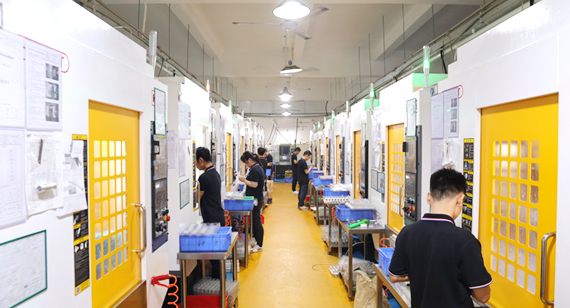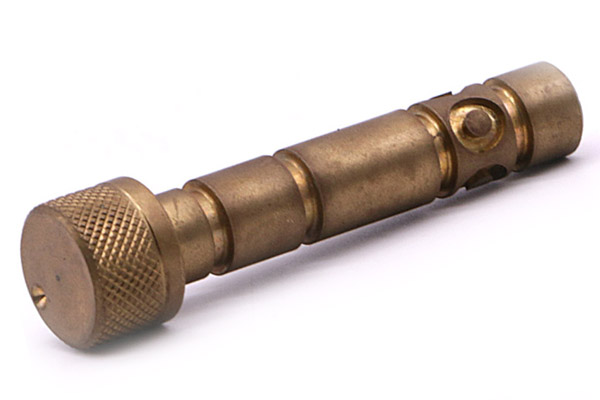Copper has been a commonly used raw material for industrial machining products since ancient times. It is processed into various complex-shaped stamping products, hardware, military parts and product cartridges, etc. It is also widely used in daily life, such as drainage pipes, medals, etc. in daily life. Electrical parts, musical instruments, valves and pipe fittings, etc.

Why do precision brass parts oxidize and turn black when processed?
1. Because copper is an active metal atom, it is prone to chemical reactions when exposed to oxygen for a long time. Most metals will turn black after oxidation, forming copper oxide. The chemical reaction formula is: 2cu+o2=2cuo
2. Corrosive substances such as strong acids and alkalis remain on the surface
3. There is oil residue on the surface after CNC machining, causing oxidation and discoloration of the copper surface;
Many times, brass parts processed from precision parts are oxidized and blackened before they are sent to customers. The quality is reduced, affecting the appearance, and even rework, increasing costs.

Why does the sealing oil of brass CNC machined parts turn black after polishing?
The reason why black spots appear in the sealing oil after mirror polishing of brass CNC parts may be due to the following factors:
1. Grease oxidation: The grease used to seal the brass surface may oxidize over time. Chemicals produced during the oxidation process of grease may cause black spots to appear on the surface.
2. Contaminants: During the oil sealing process, if there are contaminants on the brass surface, such as dust, corrosives or other organic matter, the interaction between the grease and these contaminants may lead to the formation of black spots.
3. High temperature: Some greases may degrade and produce carbides at high temperatures. If the grease used in the oil sealing process cannot withstand high temperatures, or the brass surface is affected by excessive temperatures during the oil sealing process, the carbonization reaction of the grease may cause black spots to appear.
4. Improper cleaning: The brass surface may not have been adequately cleaned before oil sealing, or inappropriate cleaning agents may have been used during the cleaning process. Remaining dirt or detergent may react with oil and grease, causing black spots to form.
How to prevent oxidation and discoloration of brass – copper anti-corrosion, copper passivation, and anti-oxidation treatment solutions
1. If the oxidation is slight, you can directly use the copper brightening cleaner T101 to soak and clean. Generally, the soaking time is 1 to 3 minutes to restore the original gloss of the copper, then clean it with water, and use the copper anti-discoloration agent T401 to dull it. Chemical anti-rust treatment prevents copper parts from oxidizing and turning black after a period of time (copper parts treated with the above process can restore the original luster of the copper parts and remain as bright as new for more than a year without oxidation)
2. If the copper parts are seriously oxidized and the base material of the copper parts is corroded deeply, a corroded spot will easily remain on the surface after cleaning the copper parts, affecting the appearance. At this time, you can use copper environmentally friendly polishing liquid T302 for chemical polishing. Polishing treatment quickly restores its brightness, and the brightness can even be improved to close to mirror gloss. After polishing, passivation and anti-oxidation treatment can be performed.
3. The principle of passivation treatment is to attach a chemical conversion film. Because it is a chemical conversion film, it cannot be touched by hand. It does not affect the conductivity, weldability, workpiece size, etc. and the hardness will not change.
The treatment process is as follows: Use a stainless steel container to fill the passivation liquid, put the workpiece to be processed and soak it for about 5 minutes, then take out the workpiece, rinse it with water and dry it; note that before passivation, the workpiece must be pre-treated , the purpose is to prevent oil stains or oxides on the surface of the workpiece. It needs to be degreased or cleaned and oxidized first. You can use a cleaning agent or degreasing agent to remove the stains, and then clean the surface for passivation protection. In order to increase the brightness of CNC parts, you can also use polishing agent to polish the surface before processing. The polishing process does not require any equipment in the whole process, and you can use direct soaking.
Brass CNC Machined Parts Protection Types:
Types of copper protection: physical protection, chemical passivation, chemical plating protection, etc. Physical protection mainly includes spraying anti-rust paint, sealing wax, etc.;
Chemical passivation protection mainly includes traditional chromate passivation (hexavalent chromium is highly carcinogenic and has been banned), and organic corrosion inhibitor passivation (representative product is Mebeshi MS0423, which does not contain any toxic heavy metals);
Chemical plating protection mainly includes tin plating, nickel plating, chromium plating, zinc plating, etc. The main purpose of these protective measures is to isolate the corrosive medium from the copper base to prevent further corrosion.
At present, in brass CNC processing factories, the main processing technology for surface protection treatment of brass CNC parts is: CNC processing → oil removal treatment → oxide layer removal → copper material protection treatment → drying and packaging (the process steps are based on different products) condition slightly increases or decreases, copper protection steps are essential)
After the above operations, the oxidized copper material will return to its original brightness after treatment. In order to prevent secondary oxidation, antioxidant treatment must be done. Previous articles have mentioned how to prevent copper material from curing and how to maintain it.
Looking for a reliable cooperative CNC machining factory
Are you looking for the right CNC machining manufacturer? Why not give CNCMF CNC machining factory a try and let us help you.
We provide customized CNC machining and surface treatment services for copper, stainless steel, aluminum, titanium and other metal materials. Focusing on precision CNC machining and production for 13 years, whether it is prototype CNC machining and manufacturing or small batch CNC machining parts production, our team of professional engineers can choose the appropriate CNC machining process and surface treatment for you, reduce your production costs, and meet high standards Satisfy your needs. Choose, just upload your CAD files to our email: [email protected] to get a project quote.